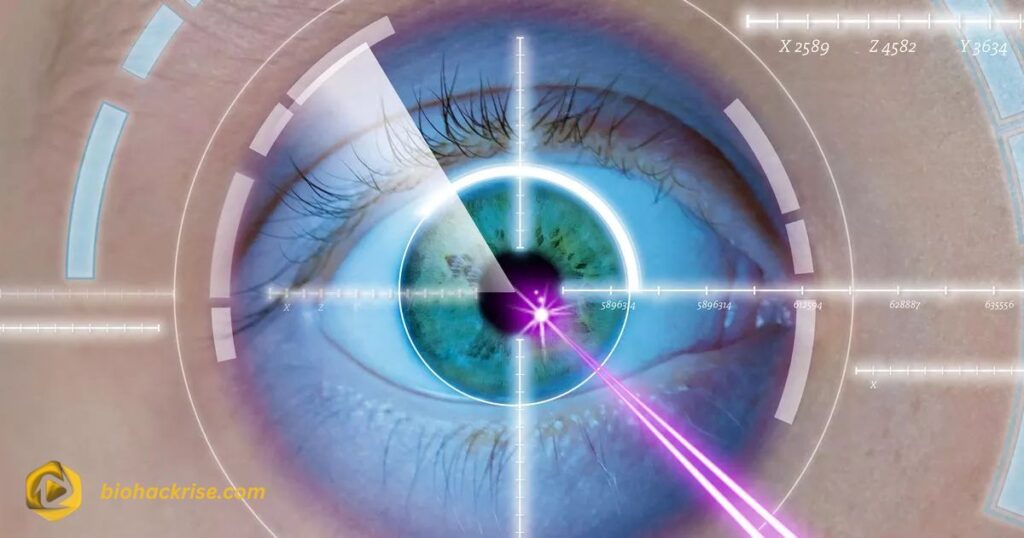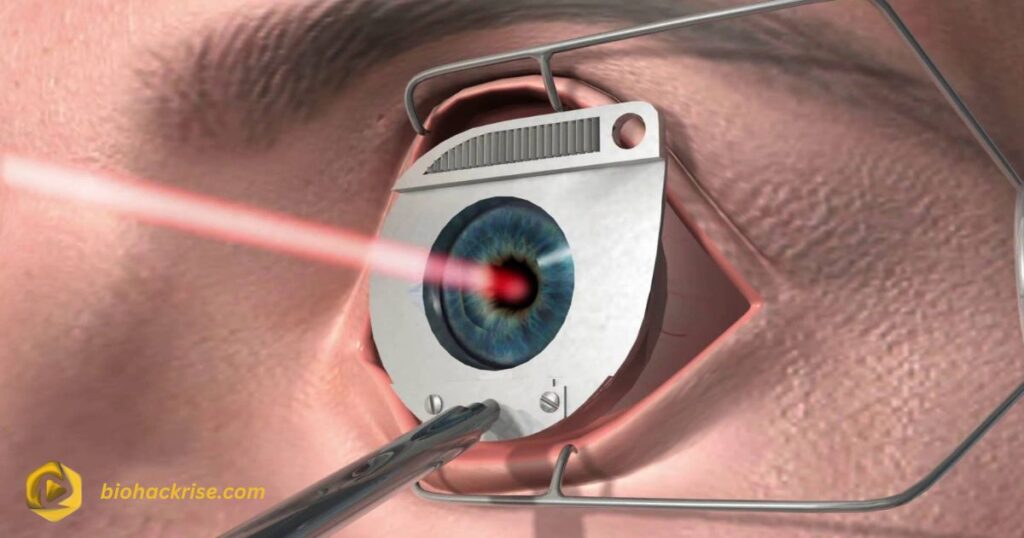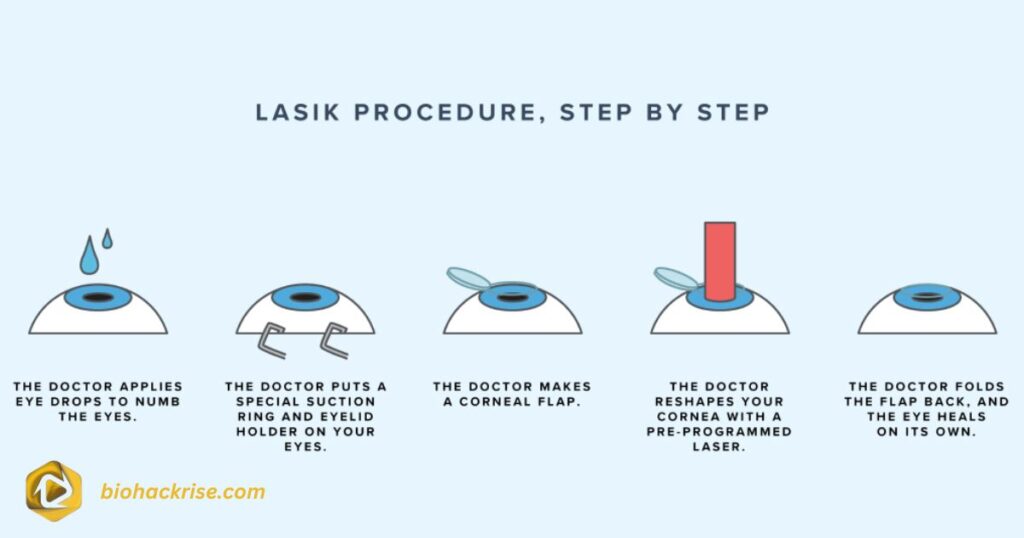Is LASIK Worth It in 2025? Costs, Benefits and Risks
If you’re tired of glasses slipping off your nose or contact lenses drying your eyes out, chances are you’ve thought about LASIK surgery. The promise of clear, sharp vision without lenses is tempting but is LASIK really worth it in 2025? With advancing technology and increasing success rates, this question deserves a thorough, honest answer.
In this in-depth guide, we’ll explore every aspect of LASIK from costs and candidacy to recovery, long-term results, and patient experiences. By the end, you’ll know whether LASIK is the right choice for you or if you should keep reaching for your glasses.
Understanding LASIK Eye Surgery
LASIK (Laser-Assisted In Situ Keratomileusis) is a type of refractive eye surgery that reshapes the cornea to correct vision problems such as nearsightedness (myopia), farsightedness (hyperopia), and astigmatism. The procedure involves using a highly specialized laser to create a thin flap in the cornea, reshape the underlying tissue, and then reposition the flap.
The whole process usually takes around 15 minutes per eye and is performed under local anesthesia (numbing eye drops). The majority of patients experience improved vision within 24 to 48 hours, often achieving 20/20 vision or better.
Modern LASIK has evolved significantly since it was first approved by the FDA in 1999. Today, advanced techniques such as Wavefront-guided LASIK, bladeless LASIK (IntraLASIK) and SMILE (Small Incision Lenticule Extraction) have made the procedure more precise, customizable, and safer than ever.
Who Is a Good Candidate for LASIK?
Not everyone qualifies for LASIK surgery. To determine candidacy, ophthalmologists evaluate several factors:
- Age: Most surgeons recommend being at least 18 years old, ideally in your mid-20s when your vision has stabilized.
- Stable Vision: Your prescription should remain unchanged for at least 12 months prior to surgery.
- Eye Health: Conditions like severe dry eyes, glaucoma, cataracts, or corneal diseases can disqualify candidates.
- Overall Health: Autoimmune diseases, diabetes, or medications that interfere with healing may increase risks.
- Corneal Thickness: LASIK requires a minimum corneal thickness to safely create a flap. Thin corneas may be better suited for alternatives like PRK or SMILE.
Your ophthalmologist will perform a detailed eye exam and mapping to determine if LASIK is right for you.
How Much Does LASIK Cost in 2025?
LASIK is considered an elective procedure, meaning most insurance plans don’t cover it. In 2025, the average cost of LASIK in the U.S. ranges from $2,000 to $3,500 per eye, depending on several factors:
| Factor | Cost Impact |
| Type of LASIK (standard vs. custom) | +$500–$1,000 per eye |
| Surgeon’s experience | Higher for top surgeons |
| Clinic location | Urban centers usually cost more |
| Technology used | Bladeless or Wavefront-guided LASIK is more expensive |
| Post-op care | May add $300–$500 |
While the upfront cost may seem high, many patients view LASIK as a long-term investment. When you consider the annual expenses of glasses, contact lenses, cleaning solutions, and eye exams, LASIK can actually pay for itself within 5–7 years.
Benefits of LASIK Eye Surgery

There’s a reason LASIK remains one of the most popular elective surgeries in the world. The benefits are both immediate and long-lasting:
- Instant Vision Improvement: Most patients experience 20/25 vision or better within 24 hours.
- Freedom from Glasses and Contacts: No more foggy lenses, dry contacts, or cleaning hassles.
- Quick Recovery: Minimal downtime—many people return to work the next day.
- Long-Term Stability: Once healed, results are typically permanent for most patients.
- Enhanced Quality of Life: Everyday activities like swimming, driving, and exercising become easier and more enjoyable.
Studies show that over 95% of LASIK patients are satisfied with their results, making it one of the most successful elective procedures worldwide.
Potential Risks and Side Effects of LASIK
Like any surgical procedure, LASIK carries some risks. Fortunately, complications are rare, especially when performed by an experienced surgeon. However, it’s essential to understand potential side effects before making a decision:
- Dry Eyes: Temporary dryness is common and usually managed with lubricating drops.
- Glare and Halos: Some patients experience glare or halos around lights, especially at night.
- Under or Overcorrection: A small percentage may need enhancement surgery.
- Flap Complications: Rare but possible if the corneal flap doesn’t heal correctly.
- Vision Regression: Very uncommon but may occur over years.
The good news is that technological advancements in LASIK have significantly reduced the frequency and severity of these side effects.
LASIK vs. Contact Lenses and Glasses: Cost Comparison
To see if LASIK is “worth it,” let’s compare the long-term cost of LASIK to wearing glasses or contacts:
| Expense Type | Average Annual Cost | 10-Year Cost |
| Glasses (frames, lenses, exams) | $300–$500 | $3,000–$5,000 |
| Contact Lenses (lenses, solution, exams) | $350–$700 | $3,500–$7,000 |
| LASIK (one-time) | $4,000–$7,000 | $4,000–$7,000 |
When you do the math, LASIK breaks even within 5–7 years compared to continuous eyewear expenses. Add to that the convenience of not relying on lenses daily, and it’s easy to see why many people consider it a worthy investment.
What Is the LASIK Recovery Process Like?
The recovery process after LASIK is often much quicker and smoother than most people expect. The actual surgery takes less than 30 minutes for both eyes, and you can usually go home shortly afterward. Your vision might be a bit blurry at first like looking through fogged-up glass but within 24 to 48 hours, most patients notice dramatic improvements.
Here’s what the typical LASIK recovery timeline looks like:
1. First 24 Hours
You’ll need someone to drive you home after the procedure. It’s crucial to rest your eyes and avoid rubbing them. You’ll likely experience mild discomfort, such as dryness, itching, or a sensation of something in your eye. Your doctor will prescribe lubricating and antibiotic drops to aid healing and prevent infection.
2. First Week
Vision clarity continues to improve daily. You should avoid swimming, makeup, and heavy exercise to prevent irritation or infection. Most patients can return to work within 1–2 days, but screen time should be limited initially.
3. First Month
Your surgeon will schedule several follow-up visits to monitor healing. Dryness may still occur, but it typically subsides with time.
4. Long-Term
By 3–6 months, your vision should stabilize completely. In rare cases, an enhancement procedure may be needed to fine-tune results.
Most patients are amazed by how quickly they recover and can return to normal life often with better vision than they ever had with glasses or contacts.
RELATED POST: Christa Podsedly The Inspiring Life of Scott Steiner’s Wife
LASIK Success Rate and Long-Term Results
Modern LASIK surgery has one of the highest success rates among all elective medical procedures. According to the American Refractive Surgery Council, more than 96% of patients achieve 20/20 vision or better, and 99% achieve at least 20/40 good enough to pass a driver’s test without corrective lenses.
Even more impressive is how durable these results are. Studies show that over 90% of patients maintain their vision correction 10 years after surgery. While natural aging (like presbyopia) can still affect close-up vision later in life, the core results of LASIK remain stable.
With proper post-op care and regular eye checkups, LASIK is not just a short-term fix it’s a long-term solution for millions.
Common Myths About LASIK Eye Surgery

Despite decades of successful results, LASIK is still surrounded by myths and misconceptions. Let’s clear up a few:
Myth 1: LASIK Is Painful
Reality: LASIK is virtually painless. Numbing drops ensure you feel no pain during the procedure. Most patients describe only mild pressure or dryness afterward.
Myth 2: LASIK Causes Blindness
Reality: The risk of vision loss from LASIK is extremely rare less than 0.1%. In fact, you’re more likely to develop serious eye infections from contact lenses than from LASIK.
Myth 3: Results Don’t Last
Reality: LASIK permanently reshapes your cornea. While age-related changes can affect near vision, the correction for distance typically lasts a lifetime.
Myth 4: Everyone Can Get LASIK
Reality: Not true. People with thin corneas, unstable vision, or certain medical conditions might not be ideal candidates. Alternative procedures like PRK or SMILE could be better suited.
By separating fact from fiction, it’s easier to make an informed, confident decision about whether LASIK is worth it for you.
Alternatives to LASIK Eye Surgery
If you’re not a candidate for LASIK, there are several excellent alternatives that might suit your needs:
- PRK (Photorefractive Keratectomy): Ideal for people with thin corneas. The surface layer of the cornea is removed instead of creating a flap. Recovery takes longer but results are similar.
- SMILE (Small Incision Lenticule Extraction): A minimally invasive laser procedure that doesn’t require a corneal flap. Great for people with dry eyes or contact lens intolerance.
- ICL (Implantable Collamer Lens): A removable lens is placed inside the eye. Suitable for high prescriptions or thin corneas.
- LASEK: A hybrid between PRK and LASIK, designed for specific corneal shapes.
Discussing all options with a qualified ophthalmologist ensures you get a personalized solution that fits your eyes, lifestyle and budget.
LASIK Technology Advancements in 2025
Technology in vision correction has advanced tremendously, and 2025 brings even more precision to LASIK. Some of the latest innovations include:
- AI-Guided LASIK Mapping: Artificial intelligence now helps map corneal irregularities with unprecedented accuracy, ensuring safer and more predictable outcomes.
- Wavefront Optimization: Customizes treatment to each patient’s unique corneal shape, minimizing glare and halos.
- Femtosecond Lasers: Replace traditional blades for flap creation, resulting in cleaner cuts and faster recovery.
- Topography-Guided LASIK: Corrects subtle corneal imperfections for sharper, high-definition vision.
These technological breakthroughs mean modern LASIK is safer, more accurate and more comfortable than ever before further increasing its worth and appeal.
How to Choose the Right LASIK Surgeon?
Selecting the right surgeon is perhaps the most crucial factor in ensuring a successful LASIK experience. Here’s what to look for:
- Board Certification: Choose a surgeon certified by the American Board of Ophthalmology.
- Experience: Preferably someone who has performed thousands of LASIK procedures.
- Technology: Make sure the clinic uses the latest laser equipment and diagnostic tools.
- Transparent Pricing: Avoid “too good to be true” discounts; they often hide additional fees or use outdated technology.
- Patient Reviews: Check independent reviews, not just testimonials on their website.
Remember: You’re not just paying for surgery you’re paying for precision, safety and experience.
Preparing for LASIK: What to Expect Before Surgery
Preparation plays a key role in the success of LASIK surgery. While the actual procedure is fast and relatively simple, the weeks leading up to it require careful planning and cooperation with your eye specialist. Here’s a breakdown of what to expect before your big day:
1. Initial Consultation
Your LASIK journey begins with a comprehensive eye exam. The surgeon will measure corneal thickness, pupil size, refractive error and overall eye health. You’ll discuss your lifestyle, vision goals, and any medical conditions that might affect healing.
This is also your chance to ask questions no matter how small. A good surgeon will take time to explain every detail, from what happens during the procedure to how your recovery will go.
2. Stop Wearing Contact Lenses
Most surgeons advise patients to stop wearing soft contact lenses 1–2 weeks before surgery, and rigid gas-permeable lenses 3–4 weeks prior. This allows your corneas to return to their natural shape, ensuring accurate measurements and the best surgical results.
3. Medication and Lifestyle Adjustments
Avoid using eye makeup, lotions, or perfumes on the day of surgery. Your doctor might prescribe antibiotic or anti-inflammatory eye drops beforehand to minimize infection risk. Make sure you arrange transportation, as you won’t be able to drive home after the procedure.
4. Mental Preparation
It’s completely normal to feel nervous before LASIK. Remember, millions of people have undergone this surgery with excellent outcomes. Understanding the process and trusting your surgeon will help ease anxiety.
The LASIK Procedure: Step-by-Step Breakdown

Let’s walk through what actually happens during LASIK surgery. The entire process is usually completed in less than 30 minutes and most patients are awake throughout comfortably and pain-free.
- Numbing Drops Applied: These eliminate pain sensations. You’ll remain fully awake but relaxed.
- Corneal Flap Creation: Using either a microkeratome blade or a femtosecond laser, your surgeon creates a thin flap on the cornea’s surface.
- Reshaping the Cornea: A computer-controlled excimer laser removes microscopic amounts of tissue to correct the refractive error.
- Flap Replacement: The flap is gently placed back in position, adhering naturally without stitches.
- Immediate Recovery: You’ll rest briefly before heading home with protective shields to avoid touching your eyes.
The entire process is fast, safe and precise guided by years of research and cutting-edge technology.
Post-LASIK Care: Dos and Don’ts
After your LASIK procedure, following your doctor’s instructions is critical for a smooth recovery and the best visual results. Here’s what you need to know:
Do’s:
- Use prescribed eye drops exactly as directed.
- Wear sunglasses outdoors to protect from UV rays.
- Attend all follow-up appointments.
- Rest your eyes for the first 24–48 hours.
- Maintain a clean, dust-free environment.
Don’ts:
- Don’t rub or touch your eyes.
- Avoid swimming, hot tubs, or steam rooms for two weeks.
- Skip makeup, lotions, or perfumes near the eyes for several days.
- Avoid intense physical activity or contact sports for a week.
By adhering to these guidelines, you’ll minimize the risk of infection and ensure a quick, complication-free recovery.
LASIK for Different Age Groups
The effectiveness and suitability of LASIK can vary depending on your age. Here’s what to expect:
In Your 20s:
This is often considered the ideal age for LASIK. Vision has typically stabilized, and younger patients heal faster.
In Your 30s to 40s:
Still a great time for LASIK, but presbyopia (age-related near vision loss) may begin to develop in your 40s. Some people may still need reading glasses later in life.
In Your 50s and Beyond:
Patients in this age group should be screened for cataracts and other age-related conditions before considering LASIK. Alternatives like lens replacement surgery might be more suitable.
Your surgeon will help you determine which procedure best fits your age, eye condition, and vision goals.
LASIK Financing and Payment Options
Since LASIK isn’t covered by most insurance plans, many clinics offer flexible payment solutions to make it more accessible.
- Financing Plans: Most LASIK centers partner with lenders to provide zero or low-interest payment options.
- FSA/HSA Accounts: You can use pre-tax dollars from your Flexible Spending Account (FSA) or Health Savings Account (HSA) to pay for LASIK.
- Employer Discounts: Some companies offer vision correction benefits or discounts at affiliated clinics.
- Promotional Packages: Clinics may offer seasonal or referral-based promotions always check credentials before signing up.
By using these financing tools wisely, LASIK can fit comfortably within your budget without compromising quality or safety.
Patient Testimonials: Real Stories, Real Results
Hearing from people who’ve had LASIK is one of the most reassuring ways to understand its value. Here are some examples:
“I had LASIK two years ago, and it’s the best investment I’ve ever made. Waking up and seeing clearly every morning still feels like magic.” – Jessica M.
“I was nervous at first, but the procedure was quick and painless. My vision improved instantly, and I haven’t touched my glasses since.” – David R.
“I used to spend hundreds yearly on contacts and solutions. LASIK not only saved me money—it changed how I experience life.” – Elena P.
These real-life stories highlight the life-changing benefits of LASIK and why so many people find it worth every penny.
Is LASIK Really Worth It? The Final Verdict
So, is LASIK worth it? For most people absolutely yes. When you weigh the long-term financial savings, convenience, and the freedom of clear vision, it’s easy to see why LASIK remains a top choice.
However, LASIK isn’t for everyone. Success depends on proper screening, choosing the right surgeon, and realistic expectations. The key is to make an informed decision with professional guidance.
If you’re tired of fumbling for glasses or dealing with irritating contacts, LASIK could be the life-changing solution you’ve been searching for
FAQ’s
How long does LASIK last?
LASIK permanently reshapes your cornea. Most patients enjoy clear vision for decades, though age-related changes may affect near vision later in life.
Can LASIK fix astigmatism?
Yes! Modern LASIK technology can accurately correct mild to moderate astigmatism, along with nearsightedness and farsightedness.
Does LASIK hurt?
Not at all. Numbing drops make the procedure painless. You might feel slight pressure, but no pain.
How soon can I drive after LASIK?
Most patients can safely drive within 24–48 hours after surgery, once vision stabilizes.
Is LASIK covered by insurance?
Generally, LASIK isn’t covered by insurance since it’s elective, but FSAs and HSAs can help offset costs.
Conclusion
LASIK has come a long way from its early days. In 2025, it’s safer, more effective, and more accessible than ever before. With modern laser technology, experienced surgeons, and impressive success rates, LASIK continues to transform lives worldwide.
Whether you’re seeking freedom from glasses or looking to simplify your routine, LASIK offers a permanent solution that’s worth serious consideration. Just remember knowledge and preparation are key to achieving the best results.




